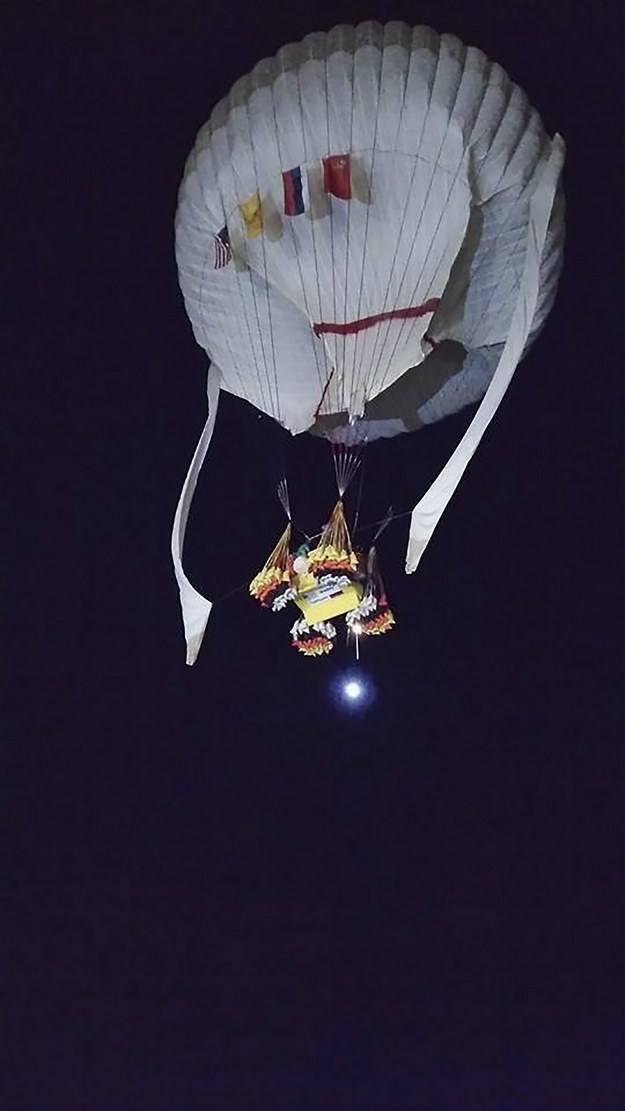Update: On Saturday morning, the pilots in the Two Eagles Balloon safely landed off the coast of Mexico after a 7,000 mile trip across the Pacific Ocean, setting a new record for ballooning.
The pilots landed 4 miles offshore in Baja California, and were greeted by a group of fellow balloon enthusiasts who were tracking their journey, the Associated Press reported. As the pilots approached the water, they dropped thick ropes into the sea to help slow down prior to their controlled water landing.
The pilots' teammates and family celebrated with relief in a mission control room in Albuquerque, where a screen projected a map of their travels and eventual descent into the ocean.
Just miles from the beach now. @TwoEaglesTeam mission control focused.
Original story:
The Two Eagles balloon was well on its way Thursday to setting a new world record for human flight in a gas balloon.
The pilots — Troy Bradley of Albuquerque and Leonid Tiukhtyaev of Russia — traveled farther than the 5,209-mile record set by the Double Eagle V in 1981, their team announced.
To set a new record, a crew must exceed a current record by 1%, as confirmed by the Federation Aeronautique Internationale, which the Two Eagles flight did by Thursday afternoon after surpassing the 5,260-mile marker.
On Friday, Bradley and Tiukhtyaev also passed the record for amount of time spent in the air.
The current record of 137 hours, 5 minutes and 50 seconds was set in 1978 during the first trans-Atlantic balloon flight.
At 7:29 a.m. MT, the Two Eagles balloon passed the record, and then beat it by at least an additional 1% at 8:51 a.m., mission control reported. The crew was still roughly 400 miles from its landing point in Baja Mexico, which they expected to reach on Saturday.

After launching from Japan on Jan. 25, the strategy was to travel north along a strong high pressure ridge off the U.S. West Coast and swing inland into Canada.
But on Thursday, the team had to change their plans after hitting a ridge of high pressure west of California. Forced to either go right or left, the crew decided to change altitude and start tracking south with the anticipation of landing in Baja California on Saturday.
They expected the weather to cooperate as the balloon heads south toward Baja, where the chance for inclement weather increases.
The northerly course would have taken the pilots over the Canadian Rockies to somewhere in the northern U.S., possibly Montana or North Dakota, the Associated Press reported.
The balloon has hit speeds in the 70 to 80 mph range, with cruising altitudes ranging from 15,000 to around 18,000 feet.

While making history, the detour and added hours to the trip was apparently starting to take its toll on the pilots.
In a status update on their website, mission coordinators said the pilots "are in good shape but understandably getting tired after nearly five days in the air."
The helium-filled envelope with a specially-designed carbon fiber-composite capsule, is designed to stay in the air for up to 10 days.

And with that, we leave you with this fun fact:
The Two Eagles flight took off with nearly 5 tons of sand (9,360 pounds) contained in 40-pound bags that the crew has been throwing overboard to maintain altitude (seen hanging from the craft above).
Without dropping the weight, the craft would steadily drop since the balloon over-pressurizes and "burps" gas as it heats during the day. Gas is also expelled to maneuver.

